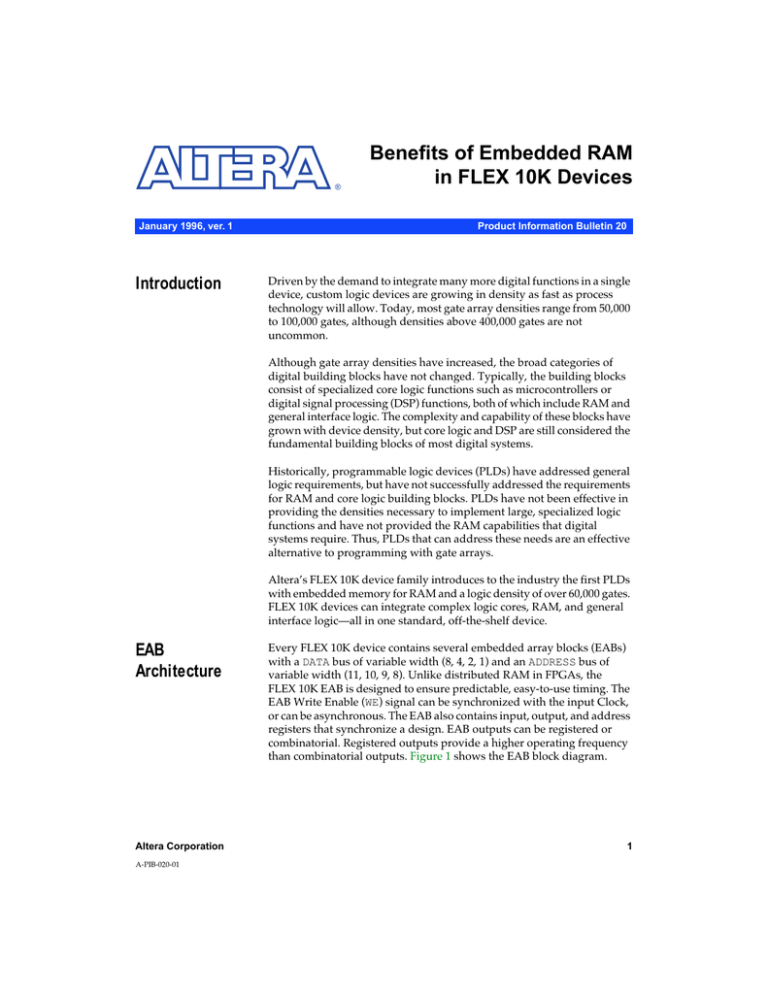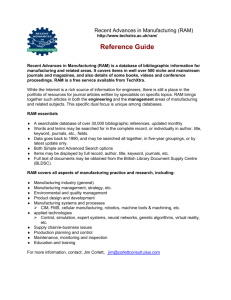
®
January 1996, ver. 1
Introduction
Benefits of Embedded RAM
in FLEX 10K Devices
Product Information Bulletin 20
Driven by the demand to integrate many more digital functions in a single
device, custom logic devices are growing in density as fast as process
technology will allow. Today, most gate array densities range from 50,000
to 100,000 gates, although densities above 400,000 gates are not
uncommon.
Although gate array densities have increased, the broad categories of
digital building blocks have not changed. Typically, the building blocks
consist of specialized core logic functions such as microcontrollers or
digital signal processing (DSP) functions, both of which include RAM and
general interface logic. The complexity and capability of these blocks have
grown with device density, but core logic and DSP are still considered the
fundamental building blocks of most digital systems.
Historically, programmable logic devices (PLDs) have addressed general
logic requirements, but have not successfully addressed the requirements
for RAM and core logic building blocks. PLDs have not been effective in
providing the densities necessary to implement large, specialized logic
functions and have not provided the RAM capabilities that digital
systems require. Thus, PLDs that can address these needs are an effective
alternative to programming with gate arrays.
Altera’s FLEX 10K device family introduces to the industry the first PLDs
with embedded memory for RAM and a logic density of over 60,000 gates.
FLEX 10K devices can integrate complex logic cores, RAM, and general
interface logic—all in one standard, off-the-shelf device.
EAB
Architecture
Every FLEX 10K device contains several embedded array blocks (EABs)
with a DATA bus of variable width (8, 4, 2, 1) and an ADDRESS bus of
variable width (11, 10, 9, 8). Unlike distributed RAM in FPGAs, the
FLEX 10K EAB is designed to ensure predictable, easy-to-use timing. The
EAB Write Enable (WE) signal can be synchronized with the input Clock,
or can be asynchronous. The EAB also contains input, output, and address
registers that synchronize a design. EAB outputs can be registered or
combinatorial. Registered outputs provide a higher operating frequency
than combinatorial outputs. Figure 1 shows the EAB block diagram.
Altera Corporation
1
A-PIB-020-01
PIB 20: Benefits of Embedded RAM in FLEX 10K Devices
Figure 1. EAB Block Diagram
EAB
8, 4, 2, 1
Q
8, 4, 2, 1
DATA
D
Q
DATA
In
DATA
Out
D
8, 4, 2, 1
Q
8, 4, 2, 1
8, 4, 2, 1
8, 4, 2, 1
RAM/ROM
11, 10, 9, 8
ADDRESS
11, 10, 9, 8
11, 10, 9, 8
WE
ADDRESS
Q
D
D
Q
Write
Pulse
Circuit
256 × 8
512 × 4
1,024 × 2
2,048 × 1
WE
Input
CLK
Output
CLK
Using EABs
The EAB RAM size is flexible; therefore, you are not limited to one
RAM configuration such as 2,048 words of 1 bit each. The following
RAM sizes are available:
■
■
■
■
256 × 8
512 × 4
1,024 × 2
2,048 × 1
The width of the DATA and ADDRESS buses varies with the size of the
RAM. You can configure an EAB for any size with standard EDA
tools or with Altera’s MAX+PLUS II development system. Figure 2
shows a graphical representation of the flexible RAM sizes.
2
Altera Corporation
PIB 20: Benefits of Embedded RAM in FLEX 10K Devices
Figure 2. EAB Memory Configurations
256 × 8
Embedded vs.
Distributed RAM
512 × 4
1,024 × 2
2,048 × 1
Most field-programmable gate arrays (FPGAs) distribute RAM,
allowing the user to choose how a particular array of memory cells
will be utilized—for example, as part of the general logic array or as
addressable RAM. However, using distributed memory in
applications requiring RAM blocks larger than 32 × 1 results in lower
performance and lower device utilization in FPGAs.
In contrast, FLEX 10K devices feature embedded RAM, and with
embedded RAM, an area of the device is dedicated to memory cells
so that the overhead structures required for RAM—addressing and
write control—are very fast and efficient. Thus, the largest FLEX 10K
device offers 24 Kbits of RAM without sacrificing logic capacity.
Figure 3 shows how the available logic of an FPGA varies with the
amount of RAM implemented in the device. Implementing RAM in
FPGAs reduces available logic, whereas implementing RAM in
FLEX 10K devices does not affect the logic capacity. As RAM sizes
increase, the logic capacity of an FPGA decreases because more logic
is required to generate the multipliers that combine small RAM
blocks. As a result, the entire device cannot be configured as RAM.
True system-level integration of complex digital designs requires
integrating RAM in addition to logic. The integration capabilities of
FPGAs are limited because they lose logic capacity when RAM is
used. According to calculations by Altera Applications, a block of
RAM as small as 12 Kbits consumes about 50% of the logic capacity
of a Xilinx XC4025E. In contrast, FLEX 10K devices have dedicated
embedded RAM for applications that require larger RAM
configurations, which can be used without impacting the logic
capacity of the device.
Altera Corporation
3
PIB 20: Benefits of Embedded RAM in FLEX 10K Devices
Figure 3. RAM vs. Logic Tradeoff
EPF10K50
Embedded Memory
3,000
2,500
2,000
Available Logic
(Logic element
equivalents)
XC4025E
Distributed Memory
1,500
1,000
500
0
0
2,048
4,096
6,144
8,192
10,240
12,288 14,336 16,384 18,432 20,480
Memory Bits (× 8 Configuration)
Source: Altera Applications
Efficiency of Embedded RAM
The FLEX 10K embedded RAM is more efficient than distributed
RAM because of its size and implementation. The size of a
fundamental FPGA RAM block is limited by its logic architecture: an
n-input look-up table (LUT) can contribute only 2n bits. Therefore,
large RAM blocks must be built from very small blocks of RAM. To
combine small RAM blocks, extra logic cells must generate wide
address decoders for writing to the RAM and address multiplexers
for reading the RAM. These extra logic cells must be used to
implement large RAM blocks even though they do not directly
contribute to the RAM size.
A high percentage of the die area required to implement RAM in an
FPGA contributes to overhead, not RAM bits. Therefore, the FPGA
architecture forces inefficiencies in RAM implementations. In fact, a
RAM block with a depth of 256 words requires approximately 10
times more die area than the same RAM block implemented in a
FLEX 10K device. The inefficiency of FPGAs directly translates into
a higher cost per bit of RAM.
4
Altera Corporation
PIB 20: Benefits of Embedded RAM in FLEX 10K Devices
In contrast, the RAM implemented in FLEX 10K devices is dedicated
as RAM. Because FLEX 10K RAM is dedicated, it is optimized for die
area and performance, and provides all the benefits of embedded
RAM. These factors make FLEX 10K embedded RAM the most
efficient RAM in the programmable logic market today.
For any given RAM size, embedded RAM is much more efficient
than distributed RAM. Figure 4 compares the relative die areas of
common RAM sizes.
Figure 4. RAM Efficiency
90
75
Relative
Die Size
(EAB = 1)
XC4025E
Distributed Memory
60
45
30
Crossover
at 32 × 8
EPF10K50
Embedded Memory
15
0
0
256
512
768
1,024
1,280
1,536
1,792
2,048
Memory Depth (× 8 Configuration)
Source: Altera Applications
Altera Corporation
5
PIB 20: Benefits of Embedded RAM in FLEX 10K Devices
RAM Performance
The length of the cycle time is a good indicator of RAM performance.
Writing to RAM involves presenting data and an address, and then
generating a write pulse to store the data in the appropriate memory
location. In FLEX 10K devices, all of the supporting circuitry for
embedded RAM is built directly into the die. Required die area is
reduced, and building the supporting circuitry into the die provides
faster, more predictable performance.
As RAM depth increases, the cycle time for an FPGA increases
because more support logic is required. In contrast, the cycle time for
a FLEX 10K device remains constant at various RAM depths because
the FLEX 10K embedded array block (EAB) has a higher logic
capacity. Figure 5 compares cycle performance versus memory size
for the Xilinx XC4025E and the Altera EPF10K50 devices.
Figure 5. Cycle Time
XC4025E-3
Distributed Memory
25
20
Cycle Time
(ns)
EPF10K50-4
Embedded Memory
15
10
5
0
0
512
1,024
1,536
2,048
Memory Depth (Words)
Source: Altera Applications
6
Altera Corporation
PIB 20: Benefits of Embedded RAM in FLEX 10K Devices
Cascading EABs for Wider RAM
For designs requiring blocks of RAM wider than an EAB
configuration, the MAX+PLUS II software automatically cascades
EABs to implement larger blocks of RAM. See Figure 6. Because
cascading FLEX 10K EABs does not require additional logic, they
have the same 13.8-ns cycle time as non-cascaded EABs.
Figure 6. Cascaded EABs
512 × 4
RAM & Control Logic
Q[3..0]
ADDRESS[8..0]
DATA[3..0]
DATA[7..4]
WE
Output CLK
Input CLK
ADDRESS [8..0]
DATA [3..0]
Q
WE
Output CLK
Input CLK
512 × 4
RAM & Control Logic
ADDRESS [8..0]
Q
Q[7..4]
DATA [7..4]
WE
Output CLK
Input CLK
Unlike FLEX 10K EABs, distributed RAM in FPGAs only has
predictable access times for small, individual RAM blocks, such as
32 × 1. As the size of the FPGA RAM increases, additional RAM
blocks are needed, and the access times become significantly slower.
For example, a 256 × 8 RAM block in a typical FPGA may require a
15.8-ns cycle time and use a significant number of device resources
in addition to RAM.
Synchronous RAM
To use a FLEX 10K EAB for synchronous RAM, the DATA and
ADDRESS signals should be registered. All control signal timing,
including the WE signal, is implemented in the EAB. Generating the
WE signal with the EAB eliminates potential glitches that can corrupt
data. When a high WE signal is clocked into the EAB, circuitry inside
the EAB generates a write pulse that meets setup and hold times for
the DATA and ADDRESS inputs. You do not have to de-assert WE to
Altera Corporation
7
PIB 20: Benefits of Embedded RAM in FLEX 10K Devices
write on consecutive Clock cycles because the synchronous EAB
allows ADDRESS inputs to change while WE is high. The WE signal
automatically pulses high on each Clock cycle.
Asynchronous RAM
You can configure the FLEX 10K EAB for asynchronous RAM using
the following guidelines:
■
■
■
Conclusion
The WE signal must be timed to avoid glitches that can
unintentionally overwrite the RAM.
The WE signal must meet the setup and hold times for the DATA
and ADDRESS inputs and signals.
The ADDRESS inputs cannot be changed while WE is high.
The die area efficiency and performance capabilities of embedded
RAM make it superior to distributed RAM. Embedded RAM is easy
to use, provides predictable timing and flexible configurations, and
creates implementations that are fast enough to fit a wide variety of
applications with complex logic functions. FLEX 10K devices are the
first high-density PLDs that are a suitable alternative to designs
typically implemented in gate arrays.
®
2610 Orchard Parkway
San Jose, CA 95134-2020
(408) 894-7000
Applications Hotline:
(800) 800-EPLD
Customer Marketing:
(408) 894-7104
Literature Services:
(408) 894-7144
8
Altera, MAX, MAX+PLUS, and FLEX are registered trademarks of Altera Corporation. The following are
trademarks of Altera Corporation: MAX+PLUS II, AHDL, and FLEX 10K. Altera acknowledges the
trademarks of other organizations for their respective products or services mentioned in this document,
specifically: Verilog and Verilog-XL are registered trademarks of Cadence Design Systems, Inc. Mentor
Graphics is a registered trademark of Mentor Graphics Corporation. Synopsys is a registered trademark of
Synopsys, Inc. Viewlogic is a registered trademark of Viewlogic Systems, Inc. Altera products are protected
under numerous U.S. and foreign patents and pending applications, maskwork rights, and copyrights. Altera
warrants performance of its semiconductor products to current specifications in accordance with Altera’s
standard warranty, but reserves the right to make changes to any products and services at any time without
notice. Altera assumes no responsibility or liability arising out of the application or use of
any information, product, or service described herein except as expressly agreed to in
writing by Altera Corporation. Altera customers are advised to obtain the latest version of
device specifications before relying on any published information and before placing
orders for products or services.
Copyright 1996 Altera Corporation. All rights reserved.
Altera Corporation
Printed on Recycled Paper.




